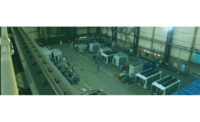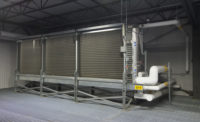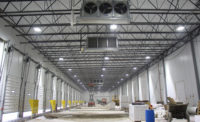Western Gateway Storage Co., Ogden, Utah, has provided innovative cold storage solutions to Utah and the surrounding states for nearly a century. With a strong commitment to client satisfaction, Western Gateway has always built state-of-the-art facilities to provide customers with the most efficient and effective technology available.
In 2016, the company carried their commitment into the 21st century by becoming what is said to be the first end user to install an Evapcold low-charge ammonia packaged refrigeration system from Evapco, Inc., Taneytown, Md. Unlike traditional stick-built ammonia systems, these packaged units are entirely self-contained and use less than 5 pounds of ammonia per ton of refrigeration (TR).
Each 70 TR package contains only 290 pounds of ammonia, for a total charge of 580 pounds for the two units. This is significantly lower than the ammonia charge for a comparable traditional stick-built, field-erected ammonia system, which could have 3,500 pounds of ammonia or more. As a result, Evapcold helped Western Gateway reduce their regulatory burden and improve plant safety, while simultaneously saving energy and simplifying operation. The small 580-pound ammonia charge is a great benefit to Western Gateway because it significantly reduces their regulatory compliance costs, particularly because of the comprehensive product and system documentation provided by Evapco.
Design
Western Gateway’s installation of Evapcold units is located at its new 30,000-square-foot, 48-foot-tall freezer in Ogden, Utah. Two Evapcold model LCR-60P-L20-2H-W units provide a combined rated capacity of 120 tons of refrigeration at a room temperature of -10°F. The Evapcold units’ optimized pumped liquid design provides excellent reliability and minimizes ammonia charge. Every component of the Evapcold system is designed to maximize efficiency and ensure reliable operation.
The AHRI 420-rated dual evaporators operate at a low recirculation rate of 1.2:1.0 and include optional variable frequency drives (VFDs) on the evaporator fans to improve efficiency when running below maximum capacity. Each unit’s screw compressor also utilizes a VFD to provide superior part-load efficiency, and is economized to maximize the overall system efficiency. Each package is rated at 60 TR for peak design conditions, but is also capable of providing 70 TR at maximum capacity by speeding up the compressor to 4,000 RPM. This capability allows for additional cooling capacity in the event that one of the units was offline for service. Because of the arid ambient conditions, the water-cooled plate and shell condenser operates at a low ammonia condensing temperature of 87°F. The Evapcold units include a machinery room with ammonia detection, ventilation, lighting and ammonia relief system to assure the safety of personnel and code compliance.
Installation
Evapcold units shorten the construction and installation schedule for refrigerated warehouses because the packages can be manufactured and shipped in parallel with the building construction schedule. Additionally, Evapcold units eliminate the need to construct a central machine room because all refrigeration components are included in the self-contained packaged unit, fabricated by Evapco. Piping, insulation and electrical wiring for Evapcold units are factory installed, significantly simplifying the scope of installation of these items in the field and shortening the overall construction schedule. End users can instead turn what would have been their central machine room into profitable revenue-generating space. Instead of eliminating the machine room and saving that cost, Western Gateway used this space to house additional refrigeration equipment that serves another building and manufacturing process, thus providing an additional revenue source for Western Gateway.
Jack Gage Refrigeration Inc., the Collinston, Utah-based refrigeration contractor for Western Gateway and installer of the Evapcold units, estimated that a stick-built installation comparable in capacity to the two Evapcold units would have required 4,000 man hours. Installing two Evapcold units, fluid coolers and associated field piping, including rigging, setting, field glycol piping and insulation, drain lines, supply air ductwork and supervisory computer, required only 800 hours. This is a tremendous savings in field labor and significantly reduces one of the largest risks for a contractor. The significant reduction in on-site labor also allows the installing contractor to perform more projects and grow business with the same resources.
Installed cost
Because of the work self-performed by Evapco during manufacturing, several costs were reduced during installation. The largest of these is eliminating the cost of constructing or expanding the central machine room. Evapcold units are also internally piped, insulated and wired and significantly reduce the work that must be performed by the refrigeration and electrical contractors.
The initial refrigeration budget for the Western Gateway project was based on a traditional stick-built system. Western Gateway and Jack Gage Refrigeration worked through several design iterations to optimize the project solution and apply a packaged low-charge ammonia solution. The Evapcold product solved the Western Gateway’s needs and the cost of the units fit within the original refrigeration budget for the project, including a small 20 TR stick-built system for the dock, the crane rental, piping and two fluid coolers. During planning and construction of the building, the general contractor accounted for the weight of the Evapcold units in the design of the building’s structural support steel.
Operation
Evapcold units also save on operational costs because of the lower electric bills, lower refrigerant costs, lower regulatory compliance costs, easier training and simplified maintenance. Western Gateway’s local utility, Rocky Mountain Power, Portland, Ore., calculated that Evapcold equipment provided an estimated energy savings of 20% annually over a typical ammonia system.
Ammonia charge. Increasing regulations are pushing owners, contractors, system designers and manufacturers to lower the refrigerant charge of their systems and thereby reduce the regulatory burdens and improve safety. Evapcold units have an ammonia charge between 1-6 pounds/TR, as opposed to 20-30 pounds/TR for traditional stick-built systems. This reduces compliance costs and significantly improves safety for personnel working at facilities cooled with Evapcold technology. It also simplifies start-up and operation because the small quantity of ammonia can be easily charged from a small cylinder instead of a large tanker truck.
The two Evapcold units at the 30,000-square-foot Western Gateway facility are each charged with 290 pounds of ammonia, for a total system charge of 580 pounds. A comparable stick-built system would require an estimated 3,500 pounds of ammonia.
Reliability. The Western Gateway Evapcold units are extremely reliable because of their pumped liquid recirculation design. The dual evaporator coils, rated in accordance with AHRI Standard 420, use the most efficient 5/8-inch enhanced stainless-steel tubes with a low 1.2:1 liquid recirculation rate. The units provide reliable liquid management and can handle operating conditions and duties that direct expansion equipment has difficulty with. Unlike other packaged systems, Evapcold units are designed to handle varying conditions, like convertible rooms, and can perform hot and cold starts and temperature pulldown while providing essential liquid management and compressor protection. This capability proved useful during the start-up of the Western Gateway facility because it allowed the units to easily handle the initial hot start conditions, when the warehouse and outside ambient temperatures were 100°F, and successfully pull down the building. It also allowed the units to run at 45°F room temperature for a month while the building was completed, and passivation of the fluid coolers took place, essentially operating as convertible room units.
Energy usage. Evapcold LCR units provide energy savings over traditional stick-built systems for several reasons. Evapcold units are internally piped and eliminate long piping runs and associated pressure drops. In stick-built systems, these long piping runs create pressure drops that cause the compressors to operate at lower suction temperatures, requiring more break-horsepower or kW. Evapcold units also consume less energy than a comparable stick-built system because the load is distributed between more units and each unit has a VFD driven compressor. VFDs are standard on the compressors and provide great efficiency at part-load. The Western Gateway units also include optional VFDs on the evaporator fans. The supervisory control system and built-in software, designed specifically for Evapcold, provide Western Gateway with powerful energy management capabilities.
The supervisory control system at Western Gateway shows the benefit of the individual Evapcold units being able to easily cycle off when the room load is satisfied.
At a maximum capacity of 70 TR, the efficiency of each compressor is 1.93 BHP/TR (1.44 kW/TR) and the grand total of the entire refrigeration system is 2.67 BHP/TR (1.99 kW/TR). Rocky Mountain Power calculated the annual energy consumption of the Evapcold units (and associated equipment) and compared it to the energy consumption of a baseline stick-built installation of a single-stage economized recirculated liquid ammonia system. The results of the comparison show a 20% annual energy savings with the Evapcold system. In addition to the 20% annual energy cost savings achieved with Evapcold, Rocky Mountain Power issued to Western Gateway a $60,000 rebate for choosing energy efficient refrigeration equipment.
Water usage.The Western Gateway Evapcold units are water-cooled to provide optimum energy efficiency. Instead of using open cooling towers to supply the cooling water, Evapco fluid coolers were installed since they provide robust freeze protection from the outside ambient with a closed-loop design. Temperatures in Ogden can easily drop below 0°F, and the fluid coolers provide freeze protection down to -8°F, and burst protection to much lower temperatures, with a 40% propylene glycol solution provided in the closed loop fluid cooler system. Western Gateway’s water-cooled system includes two Evapco ATWB 9-7K12 fluid coolers, one for each Evapcold unit.
Water treatment.Western Gateway’s fluid coolers and condensers include Evapco’s Smart Shield solid chemistry water treatment system for superior control of scale, corrosion and microbiological activity. The Smart Shield system components arrived factory-mounted on the fluid coolers, which eased the start-up and commissioning for Jack Gage Refrigeration. The Smart Shield system includes a bio-control feeder, which controls microbiological growth with granular biocide and features an integrated membrane to control chemistry release. The inhibitor feeder is easily replenished with non-hazardous scale and corrosion-inhibitor cartridges for simple reloading. Because Smart Shield is a solid chemistry water treatment system, it reduces packaging and eliminates the possibility of liquid spills, making it what is said to be the safest chemical water treatment option in the industry.
Start-up
Successful start-up of both Evapcold units occurred on June 17. Both units performed well under 100°F ambient start-up conditions. The units were then turned off and the Evapco ATWB fluid coolers ran with no load in passivation mode for several weeks while building work was completed. The Evapcold units turned back on July 7 and ran in high-temperature mode at 45°F until July 21 while the storage rack assembly was completed. Final building temperature pull-down began on July 22. The warehouse successfully pulled down to a -10°F design temperature over a 10-day period with no problems. The units are now running successfully at -10°F room temperature.
Operating benefits
Evapcold provides operators and end users with simpler operation than stick-built systems. The packaged design and user friendly control system allows for “plug-and-play” operation in which the operator has easy control of set points. If building loads change, a unit is offline for maintenance, or a different room temperature is desired, changing the operating set points of the Evapcold units is straightforward and can be done locally or remotely, even from a phone.
Evapcold units have also been designed for easier and less frequent maintenance than a comparable stick-built system. Units feature stainless-steel piping throughout, a single-point electrical connection, multiple pump-out locations, a trolley and jibs for easy removal of the compressor or motor and evaporator fans, and numerous other design features that aid in serviceability. Complete Evapcold documentation, provided with every unit, includes detailed operating procedures, preventative maintenance and inspection plans.
One of the greatest benefits that come with Evapcold units is single-source responsibility from Evapco. Stick-built systems use equipment purchased from many manufacturers, while the entire Evapcold package is manufactured by one company, making troubleshooting, customer support and warranty management easier. Every unit comes with complete documentation, including a rigging and handling manual, installation instructions, operating procedures and preventative maintenance plans. Evapcold also underwent a complete hazard review that can help the end user with on-site safety programs and process safety management.
Underfloor warming
As is the case with almost all cold storage freezers, underfloor warming is necessary to prevent under-slab ice formation and floor heaving. This is easily accomplished by recovering the waste heat from the Evapcold units and providing heat to the underfloor glycol circuits. On the Western Gateway project, Jack Gage Refrigeration used the 81°F glycol coming off the LCR water-cooled condenser before it enters the ATWB fluid coolers to supply the underfloor warming system. In addition to providing underfloor warming to the warehouse concrete slab, it also provides snow melt capabilities for the outdoor truck apron. The underfloor warming loop has the added benefit of providing free cooling to the ammonia condenser loop and reducing the load on the ATWB fluid coolers.
Lessons learned
The Evapcold installation at Western Gateway is the first of many, and there are several lessons to be learned that will aid in future projects. First, it is important to coordinate with the general contractor, architect and structural engineer during the building design phase. Installing packaged systems will eliminate or reduce the size of the central machine room. That space can be eliminated from project budgets or used for revenue-generating space.
The structural engineer will also need to account for the weight of Evapcold units when laying out roof structural steel. Evapcold units may require more localized support in the roof than typical stick-built installations.
Also, the electrical contractor will not need to perform as much site work because Evapcold units come internally wired and need to be connected at the main power feed. If general contractors take these factors into account early in the building design, they can maximize project savings.
It is also important to consider that one size or configuration does not fit all. Evapcold units can effectively cover spaces from 5,000-35,000 square feet per unit. Different Evapcold models can be optimized to provide the best overall solution for the unique layouts and cooling requirements of each refrigerated facility.
New technologies are disruptive to any industry, and refrigeration is no different. Packaged low-charge ammonia systems have many benefits, but engineers, contractors and end users are accustomed to traditional stick-built systems. This is why Evapco has invested heavily in research and development, testing and validation and manufacturing infrastructure for the Evapcold product.



